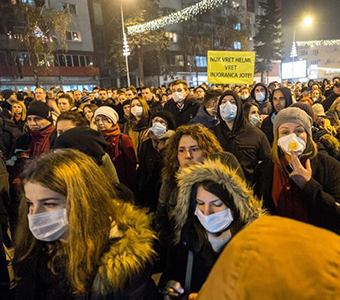While the Energy Community yesterday failed to consider more stringent air pollution rules for the Western Balkans, a new report quantifies the health costs of the region’s coal burning both within the region itself as well as in the neighbouring European Union.
Ioana Ciuta, Energy co-cordinator | 16 March 2016

I often hear that countries in the Western Balkans are too poor to invest in pollution reduction, environmental improvement, energy efficiency or renewable energy sources.
Less than three months after thousands protested in Bosnia and Herzegovina, Montenegro and Macedonia against intolerable air pollution and their governments’ inaction on the matter, a new report (pdf) by the Health and Environment Alliance (HEAL) puts a price tag of up to EUR 8.5 billion per year on the health impacts of coal plants in the Western Balkans. [1]
8.5 billion is a heavy toll for the already indebted countries of the Western Balkans, representing 13% of their collective GDPs (converted at inforeuro exchange rate).
For comparison, in the last 4 years the total amount of funds allocated to renewable energy, energy efficiency and climate change mitigation by European public banks (the European Bank for Reconstruction and Development (EBRD) and the European Investment Bank (EIB) and by EU pre-accession funds was 2.5 times less than the annual health bill, at approx. EUR 3.46 billion.
Balkan coal a major culprit, damages extend to EU countries
These countries’ energy sectors are heavily reliant on coal for electricity production, and this indeed shows in the health impacts: HEAL’s report finds that in Montenegro, for example, the Pljevlja coal plant was solely responsible for more than 90% of national SO2 and half of the NO2 emissions in 2011. Furthermore, this plant contributed 59% of PM10 emissions (coarse particulate matter) and 42% of PM2.5 emissions (fine particulate matter). Also, in Serbia, coal plants were responsible for more than 80 percent of national SO2 emissions and half of NO2 emissions in 2013. These plants were also contributing over 15 percent of PM emissions (PM2.5 and PM10). But neither of these is a match to Bosnia and Herzegovina’s Ugljevik power plant. With annual SO2 emissions at 154,380 tonnes, this is the most polluting coal plant in the whole of Europe.
An additional important finding of the report is the calculation of the health damage to neighbouring countries that is caused by coal burning in the Western Balkans. Air pollution is not limited to the proximity of the power plant. Some pollutants in exhaust clouds from the smokestack can be transported to neighbouring EU countries and beyond, thus plants in Serbia, for example, may cost the health of the local population up to 1.7 billion Euro, but add up to the health bill in the EU another 4 billion Euro.
Missed opportunities to improve air quality through Energy Community
Still, we see little progress being made in the direction of creating a level playing field between the electricity generation in the EU and that of the Western Balkans. The Energy Community, which aims to extend the EU internal energy market to South East Europe and beyond on the basis of a legally binding framework, has an opportunity to change the fate of air pollution in the Western Balkans, with strong support from affected communities and with legislative ease (see Bankwatch’s briefings on adopting the Air Quality Directive and Chapter II of the Industrial Emissions Directives). Yet, signs of progress are nowhere to be seen.
Yesterday’s meeting of the Permanent High Level Group of the Energy Community took into account a few new pieces of environmental legislation (pdf) to be adopted in the following year, unfortunately none of which tackle air quality directly.
Disappointingly enough, most governments in the region don’t seem to realise the gravity and urgency of the situation by themselves, either. The EU and Energy Community need to take a strong lead and make the Air Quality Directive and Industrial Emissions Directive (Chapter II) part of the Energy Community acquis as soon as practicably possible and provide support to governments in realising that air quality is more about health benefits than about legal burdens.
The harmonisation of the energy market cannot happen at the expense of health and environmental protection. EU decision-makers should show leadership and insist on the inclusion of all parts of EU air quality and industrial emissions legislation in the Energy Community’s requirements and closely follow its application, without further deadline extensions.
Notes
1. The report covers Bosnia and Herzegovina, Macedonia, Montenegro, Kosovo and Serbia. The EUR 8.5 billion figure consists of costs directly related to air pollution from coal-fired electricity plants, including from premature deaths, respiratory and cardiovascular hospital admissions, new cases of chronic bronchitis and lower respiratory problems, medication use and days of restricted activity due to ill-health, including lost working days.
Never miss an update
We expose the risks of international public finance and bring critical updates from the ground – straight to your inbox.
Institution: EU Funds
Theme: Energy & climate
Location: Montenegro
Project: Banovici lignite power plant, Bosnia and Herzegovina | Kolubara B lignite-fired power plant, Serbia | Kosova e Re lignite power plant, Kosovo | Kostolac lignite power plant, Serbia | Pljevlja II lignite power plant, Montenegro | Stanari lignite power plant, Bosnia and Herzegovina | Tuzla 7 lignite power plant, Bosnia and Herzegovina | Ugljevik III lignite power plant, Bosnia and Herzegovina
Tags: Energy Community | Pljevlja | Ugljevik | air pollution | air quality | coal | emissions | particulate matter
